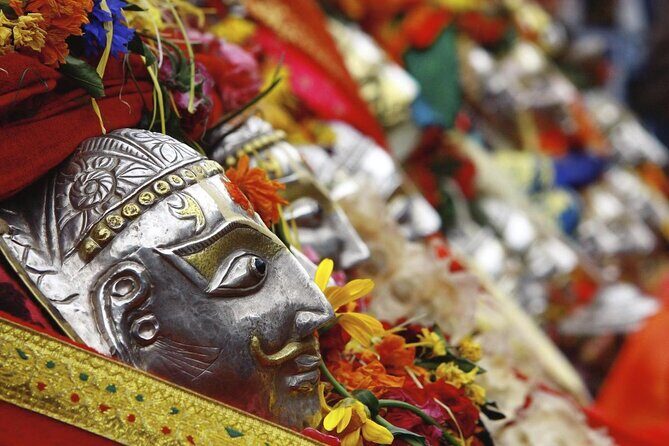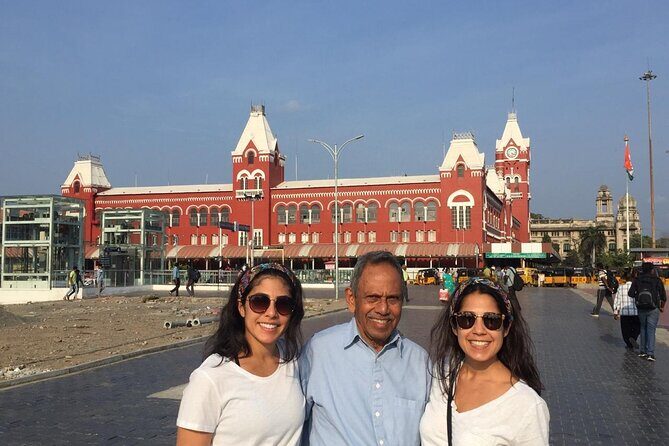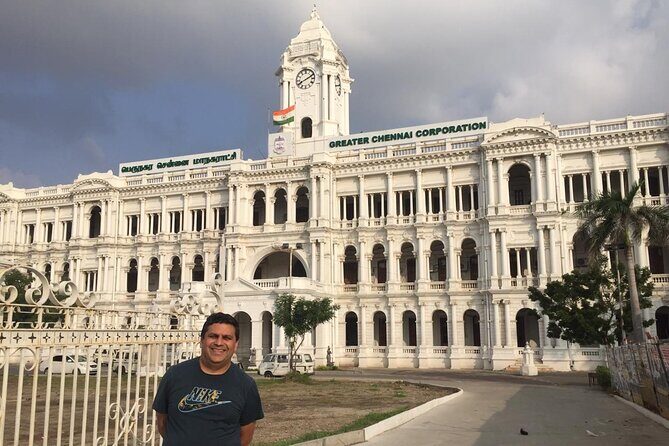Physical Address
304 North Cardinal St.
Dorchester Center, MA 02124
Physical Address
304 North Cardinal St.
Dorchester Center, MA 02124

Discover Chennai’s British architectural heritage with this engaging 2.5-hour guided walk, exploring historic buildings, bridges, and landmarks with local insights.
Exploring Chennai’s colonial past through its architecture offers a unique window into its history, culture, and the enduring influence of the British Empire. The British Architecture Walk is a well-reviewed, two-and-a-half-hour guided tour that takes you through some of the city’s most iconic British-era structures, from grand government buildings to historic bridges. Led by knowledgeable local guides, this experience promises both education and a chance to see Chennai’s cityscape from a different angle.
What we love most about this tour is the attentive small-group format, which allows for a more personalized and engaging experience. Plus, the detailed commentary from guides like Hareesh and Satish, who both receive high praise for their deep knowledge and friendly demeanor, makes the visit genuinely enriching. The inclusion of snacks and optional hotel transfers adds to the overall value, making this more than just a walk—it’s an immersive experience.
The only potential drawback is the 2.5-hour duration, which might be tight if you’re a slow walker or want to linger longer at each stop. Also, while most attractions are included in the ticket price, some sites like Victoria Public Hall and the University of Madras require separate entry tickets if you want to explore inside. This tour suits history buffs, architecture lovers, or anyone curious about Chennai’s colonial legacy who appreciates a guided, intimate outing.


If you enjoy exploring Chennai on foot, these walking tours might also suit your style
We begin at the historic Egmore railway station, which has been serving travelers for over a century. Designed by Henry Irwin, it’s a striking example of Indo-Saracenic architecture—a style that fuses Gothic, Dravidian, and other traditional Indian elements. The station was envisioned to be larger than London’s Charing Cross, which still feels astonishing when you see its grandeur.
The station’s architecture isn’t just about looks; it’s also a story of colonial ambition. Samynatha Pillai, a local builder, was commissioned to construct this massive structure, blending Gothic arches with intricate Dravidian motifs. Our guide highlights these stylistic details, showcasing how colonial and Indian influences coexisted in the design.
Next, we stroll to Chennai’s busiest train station, another masterpiece of British design. Built in 1873, the Gothic Revival style by George Harding is unmistakable, with its towering clock and ornate towers. The modifications by Robert Chisholm in the early 20th century, especially the addition of the clock tower and Travancore caps, give the building a distinctive silhouette.
The station handles over 350,000 passengers daily, making it a vital part of Chennai’s modern daily life. Our guide points out the architectural details and the historical significance—connecting the past to the present. We loved hearing about the blend of functional design and aesthetic appeal, which makes this station more than just a transit point; it’s a piece of living history.
A short walk takes us to Victoria Public Hall, opened in 1887 to commemorate Queen Victoria’s Golden Jubilee. It served as a venue for public meetings, cultural events, and even film screenings. Designed by Robert Chisholm, this Indo-Saracenic building features characteristic domes and arches that reflect the colonial-era fascination with blending styles.
The hall’s history as a community hub and its architecture make it a must-see. While the interior isn’t included in the tour, the exterior alone tells a story of colonial grandeur. One reviewer noted that the hall is an excellent example of Indo-Saracenic style, and it’s easy to see why—its ornate details and historical significance make it stand out.
The iconic Ripon Building, completed in 1913, is the administrative heart of Chennai. Designed by G.S.T. Harris and built by Loganatha Mudaliar, it’s named after Lord Ripon, the British Governor-General known for promoting local self-government. Today, it houses Chennai’s mayor, and its impressive facade still commands attention.
While the tour doesn’t include entry inside, the exterior’s stately architecture and historical context make it a photo-worthy stop. Our guide shares stories of Ripon’s influence on local governance, adding depth to the visual experience.
Continuing to the Southern Railway Headquarters, built in 1921 and designed by N. Grayson, this building exemplifies Indo-Saracenic style and was among the earliest in India to use reinforced concrete. Its architectural details, including domes and arches, echo European influences, but with Indian touches.
The building’s innovative construction methods and style reflect the British Empire’s tendency to combine practicality with grandeur. For travelers interested in engineering and architecture, this site offers a glimpse into colonial innovation.
One of Chennai’s most photographed landmarks, Napier Bridge was built in 1869 and named after Governor Francis Napier. It connects the Marina Beach to Fort St. George across the Coovum River. Originally a narrow bridge, it was widened and reconstructed in concrete in 1943.
The bridge is more than a transportation link; it’s an icon of Chennai’s skyline. The tour stops here for about 15 minutes, giving you time to appreciate its simple yet historic design, often featured in media and postcards representing the city.
The Senate House at the University of Madras, constructed between 1874 and 1879, is a stunning example of Indo-Saracenic architecture with Byzantine influences. Located along Marina Beach, it’s the university’s administrative hub and a symbol of colonial-era educational expansion.
Designed by Robert Chisholm, the building’s domes, porticos, and ornamental details are impressive. Even if you don’t go inside, seeing this structure up close offers a sense of Chennai’s development as a colonial educational center.
Finally, we visit the Victory War Memorial, originally called the “Cupids Bow.” Erected to honor the soldiers from Madras who fought in WWI and WWII, it stands as a somber tribute with a distinctive arch design. The memorial’s history as a site of remembrance lends it emotional weight, and it’s a fitting way to end the tour.
This walk offers a comprehensive look at Chennai’s colonial architecture without feeling rushed. The mix of major landmarks and lesser-known sites provides a rounded perspective on the city’s past. The small group size means you get detailed stories and the chance to ask questions, which our reviewers, like Gregg and Cheerlyn, found especially valuable.
The inclusion of snacks adds a nice touch, giving you a brief rest and a chance to chat with your guide. Plus, the optional hotel transfer is perfect if you prefer not to navigate Chennai’s busy streets on your own. The tour’s moderate price point offers excellent value considering the depth of information and access you receive.
The guides are clearly passionate and deeply knowledgeable. Gregg mentions Hareesh’s storytelling, and Cheerlyn praises Satish’s enthusiasm—both highlight how their insights made the buildings come alive. Their stories often include interesting tidbits that aren’t found in guidebooks, like the inside history of the buildings’ design choices or anecdotes about colonial Chennai.
While the tour doesn’t include inside visits to all buildings, the exterior views alone are impressive, and guide commentary ensures you understand their significance. If you’re especially interested in architecture, history, or colonial influence, this tour will meet your expectations.

It’s perfect for history buffs eager to connect the dots between Chennai’s present and past. Architecture lovers will appreciate the detailed descriptions of style and design. Travelers who enjoy storytelling and personal insights will find the guides’ enthusiasm contagious.
If you prefer a relaxed pace, ample photo opportunities, and engaging commentary, this tour offers a rewarding experience. It’s also suitable for those with limited mobility, as most sites are viewed from outside, and the walking is manageable within the allotted time.
The British Architecture Walk in Chennai is a well-crafted, engaging journey through the city’s colonial past. With expert guides, a thoughtfully curated route, and authentic stories, it offers excellent value for those interested in architecture, history, or local culture. It’s ideal for curious travelers who want more than just a sightseeing checklist—this is a chance to see Chennai’s past come to life through its buildings.
Whether you’re visiting Chennai for a few days or a longer stay, this tour provides a meaningful perspective on how colonial history shaped the city’s landscape. It’s a relaxed, informative experience that suits a wide range of travelers, especially those who appreciate detailed stories and personal touches from local guides.

Is hotel pickup included?
You can choose an option that offers hotel pickup and drop-off, making it more convenient, though it’s not included by default.
How long does the tour last?
The walk takes approximately 2 hours and 30 minutes, giving you enough time to enjoy each site without feeling rushed.
Are tickets included for all sites?
Most stops include the admission ticket in the tour price, but some sites like Victoria Public Hall and the University of Madras require separate entry tickets if you wish to explore inside.
Is this tour suitable for all ages?
Most travelers can participate, and the leisurely pace makes it accessible. It’s especially good for those interested in architecture and history.
What’s the group size?
The tour is limited to a maximum of 15 travelers, ensuring an intimate experience and ample opportunity for questions.
How is transportation arranged?
The tour is primarily a walking experience. Optional hotel transfers are available if you prefer to be picked up or dropped off at your accommodation.
What should I wear or bring?
Comfortable walking shoes and sun protection are recommended, as most of the tour is on foot outdoors.
Can I get this tour as a private experience?
While the standard group tour is designed for small groups, private arrangements may be available through the provider.
In summary, the British Architecture Walk offers an insightful, well-paced, and visually captivating look at Chennai’s colonial past, led by guides who truly know their stuff. It’s a standout choice for anyone wanting to understand the city’s historic fabric beyond the usual tourist spots.